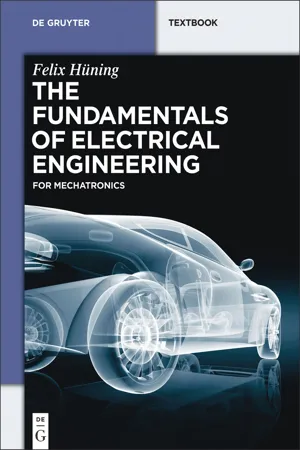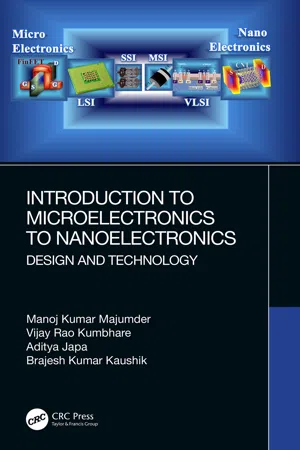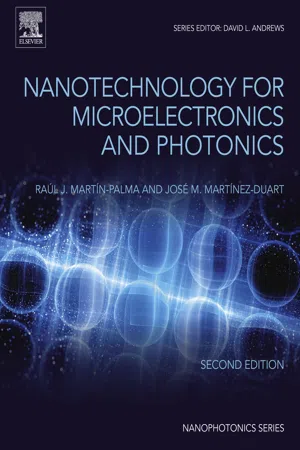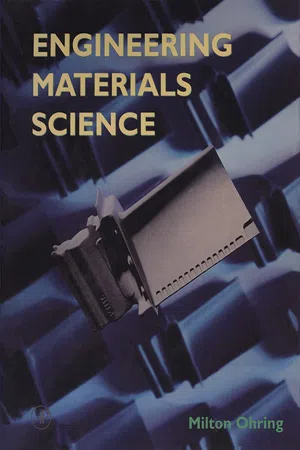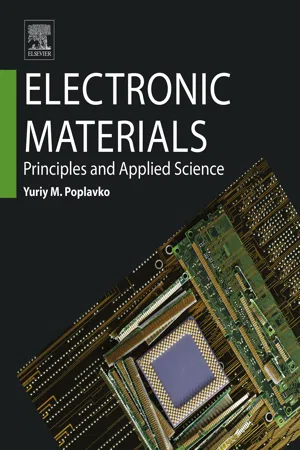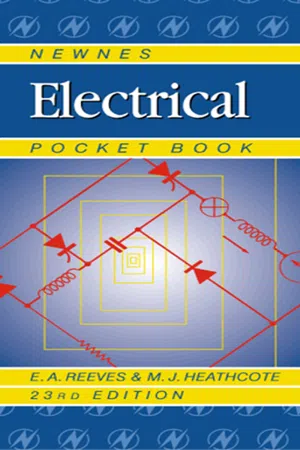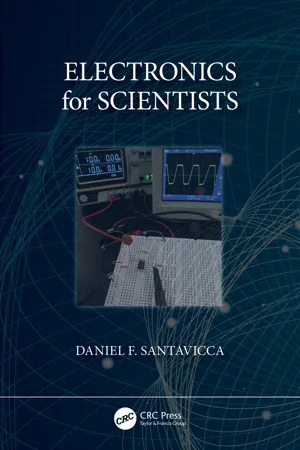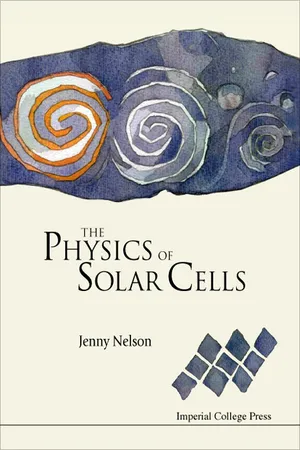Physics
Semiconductor Devices
Semiconductor devices are electronic components made from semiconductor materials, such as silicon. They have the ability to control the flow of electrical current and are fundamental to the operation of electronic devices. Common semiconductor devices include diodes, transistors, and integrated circuits, which are essential for the functioning of modern electronics.
Written by Perlego with AI-assistance
Related key terms
Related key terms
1 of 4
Related key terms
1 of 3
10 Key excerpts on "Semiconductor Devices"
- eBook - ePub
- Felix Hüning(Author)
- 2014(Publication Date)
- De Gruyter Oldenbourg(Publisher)
11 Semiconductor DevicesBasic elements like resistors, capacitors or inductors are part of almost every electronic circuit. But besides these elements in particular Semiconductor Devices are extremely important to realize any complex electronic circuit. Semiconductors are used for devices like diodes or transistors as well as for rather complex integrated circuits (IC) like microprocessors and microcontrollers. These devices in general make use of the properties of doped semiconductors and combine n- and p-doped semiconductors and metals to realize different functionalities.The basis for most Semiconductor Devices is pure silicon and compound semiconductors like SiC or GaN to some extent. Highly sophisticated processes are used to produce these Semiconductor Devices in the form of small rectangular dies. Depending on the functionality of the device (MOSFET, microprocessor, etc.) different process technologies are used, but to some extent these techniques are rather similar. The semiconductor industry is highly innovative in order to continuously improve their technologies. In particular semiconductor structures have shrunk very rapidly. According to Moore’s law the number of transistor elements per area doubles every 12–24 months.The starting point for silicon dies, or chips is an extremely pure (>99,99999999 % purity) and crystallographically very well defined (very few crystal defects) cylindrical tube of silicon called an ingot. The diameter of the ingots ranges from 100–400 mm. From the ingot thin plates of silicon of some hundred micrometers thickness are cut. The surface of each wafer is separated into small rectangular areas known as dies. Dedicated process steps like photolithography, ion implantation for n- and p-doping, chemical etching, oxidation or vapor deposition are used repetitively to produce the required structures and elements onto the wafer. Small structures of the elements like the gate length of the transistors are is just about 20 nm in 2014! Up to several billion transistors on one die of some cm2 - eBook - ePub
Introduction to Microelectronics to Nanoelectronics
Design and Technology
- Manoj Kumar Majumder, Vijay Rao Kumbhare, Aditya Japa, Brajesh Kumar Kaushik(Authors)
- 2020(Publication Date)
- CRC Press(Publisher)
1 Semiconductor Physics and Devices1.1 Introduction
Semiconductors have revolutionized the field of electronics and play a prominent role in our day-to-day life. The seed of development of these modern solid-state semiconductors dates back to early 1930s. Each electronic device that we see around is made up of semiconductors. We wouldn’t have been able to achieve these remarkable results without them.1.1.1 Conduction in Solids
The form in which matter exists is called the state of matter. Matter exists in many distinct states of which three states are well known and important. They are solids, liquids, and gases, and other states include plasma, Bose–Einstein condensates, degenerate matter, photonic matter, etc. These other states occur only in extreme conditions of pressure, temperature, and energy. The main difference in the structure of each state lies in the densities of the particles. The density of particles is highest in solids and lowest in gases. Figure 1.1 shows the alignment of particles in different states of matter and the processes through which we can convert one state of matter to another.FIGURE 1.1Alignment of particles in different states of matter.Solids are further classified into three types based upon the distance between their valence band and conduction band. This distance is called the bandgap [1 ]. The electrical conductivity of the substance depends upon the bandgap of the material. We say that the substance is able to conduct if there are free electrons in the conduction band. When energy is supplied to the elements, the electrons in the valence band get excited and jump up into the conduction band, allowing the passage of electricity through the substance. In conductive materials, no bandgap exists, due to which electrons can move easily between their valence band and the conduction band. Unlike conductors, insulators have a huge bandgap between the conduction and the valence band. The valence band remains full since no movement of electrons occurs, and as a result, the conduction band remains empty as well. In semiconductor materials, the bandgap between the conduction band and the valence band is smaller. At room temperature, there is enough energy accessible to displace a few electrons from the valence band into the conduction band. As temperature increases, the conductivity of a semiconductor material increases. Figure 1.2 - Raúl José Martín-Palma, José Martínez-Duart(Authors)
- 2017(Publication Date)
- Elsevier(Publisher)
Chapter 3 Review of Semiconductor Physics Abstract The technology of semiconductors exploded after the development of the transistor, followed by the invention of the integrated circuit and the microchip. As such, semiconductors are ubiquitous in our everyday lives, in part, because Semiconductor Devices have been found to be highly economical because of their miniaturization and reliability. Applications of semiconductors include transistors, diodes, microwave generators, solar cells, lasers, light-emitting diodes, thermistors, charge-coupled devices, and photodetectors, among others. In this chapter the key physical properties of bulk semiconductors are reviewed, from their band structure to transport and optical processes in these materials. Keywords Acceptor; Bandtail states; Biexciton; Degenerate semiconductor; Donor; Dopant; Law of mass action 3.1. Introduction We review in this chapter the physics of bulk semiconductors, which is needed for the understanding of the behavior of low-dimensional semiconductors in mesoscopic systems (Chapters 4 and 5). We will focus mainly on those electronic and optical properties related to the understanding of device applications such as transistors and lasers. The chapter starts with a description of the band structure of typical semiconductors. Next, the calculation of electron and hole concentrations in intrinsic and extrinsic semiconductors is presented. The mechanism of electron transport in semiconductors, both under the action of electric fields and carrier concentration gradients, is also revised. Generation and recombination of carriers in electric fields and under concentration gradients lead to the continuity equation and to such concepts as minority carrier lifetime and diffusion length- eBook - ePub
- Sharon Ann Holgate(Author)
- 2021(Publication Date)
- CRC Press(Publisher)
7 Chips with Everything Semiconductor Devices and Dielectrics7.1 Introduction to Semiconductor Devices
Imagine for a moment a world without any electronic equipment. In this hypothetical world, there would be no mobile phones, no computers, no games consoles, no microwave ovens, and a complete absence of a host of other electronic gadgets that we tend to take for granted. This imaginary life would be our reality if it had not been for the invention of the transistor in 1947 by American physicists John Bardeen (1908–1991), Walter Brattain (1902–1987), and William Shockley (1910–1989), coupled with an increasing understanding of the properties of semiconductor materials.The transistor, and almost every other electronic component, is made mainly from semiconductor materials, including silicon (Si), germanium (Ge)—from which many of the first electronic devices were made—and gallium arsenide (GaAs). The most widely used of these is silicon, as many electronic components contain silicon, and almost all integrated circuits are mounted on silicon chips. Silicon occurs naturally as silica (also known as silicon dioxide) in several different forms including quartz and sand. Unlike many of the Earth’s resources, silicon is so abundant that it is unlikely to become used up. This is good news, as the semiconductor industry is one of the biggest industries in the world and more and more high-tech products come on the market each year.In this chapter, we will see how some of the most common electronic devices work, what they tend to be made from, and how they are manufactured. We will also discuss insulating materials, which, as we will discover, play an important role in Semiconductor Devices.7.1.1 p-n Junctions
Forming a p-n Junction
If a layer of p-type semiconductor is sandwiched next to a layer of n-type semiconductor, a p-n junction is formed. As Section 6.4.1 explained, both p-type and n-type semiconductors are electrically neutral overall, since intrinsic semiconductors are electrically neutral, and so are any dopant atoms. So before they are joined together, the p-type and n-type sides of a p-n junction are electrically neutral, but there is a large concentration of electrons in the n-type material and a large concentration of holes in the p-type material. Figure 7.1a shows band diagrams for isolated n-type and p-type materials. The Fermi energy is near to the valence band in the p-type semiconductor, and near to the conduction band in the n-type semiconductor because in both cases, there is a high dopant concentration. (Figure 6.25 - eBook - ePub
- Milton Ohring(Author)
- 1995(Publication Date)
- Academic Press(Publisher)
12 SEMICONDUCTOR MATERIALS AND DEVICES: SCIENCE AND TECHNOLOGY 12.1 INTRODUCTION Semiconductors are a unique class of materials that have transformed society and technology in truly revolutionary ways. A reasonably large number of different semiconductor materials are used in assorted electronic and electro-optical devices. They are broadly divided into elemental and compound semiconductors. The relevant portion of the Periodic Table for these materials is indicated in Fig. 12-1. Elemental semiconductors stem from column IVA and notably include silicon, the most important of all semiconductors. In addition, there is germanium, the first semiconductor to be widely exploited in devices. Today, Ge has been virtually entirely supplanted by Si. Carbon in the form of diamond is also semiconducting. Diamond’s semiconducting properties have not yet been capitalized upon, but its remarkably high thermal conductivity has been used to draw heat away from semiconductor lasers, enabling them to operate more reliably. FIGURE 12-1 Elements of the Periodic Table that play an important role in semiconductor technology. Compound semiconductors are composed of elements drawn almost entirely from four columns of the Periodic Table, with two residing on one side next to column IVA and two adjacent to it on the other side. Columns IIB and IIIA, containing metals with nominal valences of 2 and 3, respectively, thus combine with the nonmetals of columns VA and VIA that have respective valences of 5 and 6. Important elemental and binary semiconductor materials are listed in Table 12-1, together with a complement of physical and electrical properties whose meanings will become clearer as the chapter develops. It is interesting to note that the compounds are either of the III–V type (e.g., GaAs, InP) or the II–VI type (e.g., CdTe, ZnS). Thus, eight electrons are available (3 + 5 = 8 or 2 + 6 = 8) to be shared by the atoms - eBook - ePub
Electronic Materials
Principles and Applied Science
- Yuriy M. Poplavko(Author)
- 2018(Publication Date)
- Elsevier(Publisher)
exponential increase in electrical conductivity with temperature rise. Near absolute zero semiconductors are close to insulators.- 2.
Semiconductors are crystals with a bandgap in electronic spectrum, which is in the range of 0.1–2.5 electron-volts. For example, gallium arsenide can be grouped under wide-gap semiconductors, while indium arsenide is a narrow-gap semiconductor. Among semiconductors there are some chemical elements (germanium, silicon, selenium, tellurium, arsenic, etc.), several alloys, and compounds. Almost all inorganic materials of the surrounding world are semiconductors. In nature, the most common semiconductor is silicon that occupies almost 30 percent of the earth's crust.- 3.
Semiconductors have conducting as well as dielectric properties. In semiconductor crystals, atoms are usually joined by covalent bonds (i.e., pair of electrons bounded with two atoms); these electrons require a certain level of internal energy to release from atom that characterize the difference between semiconductors and dielectrics. This energy can be applied by energy fluctuations in crystal (room temperature thermal energy level is 0.026 eV).- 4.
The analysis of Schrodinger equation for electrons in crystal (Bloch theorem) shows that electronic wave function depends on the wave vector k that module has a dimension of inverse length; by this way, the quasi-impulse p = ħk can be introduced in a consideration. This concept is very useful for examining many problems in electronic theory of solids.- 5.
In crystalline semiconductors, spatial atomic structure has long-range ordering, that is, the position of individual atoms (or groups of atoms) is repeated periodically within volume of crystal. Accordingly, the potential field is periodically changed with distance, divisible to period of structure. The compact recording of this condition is: U (r ) = U (r + na ), where a is period of structure and n - eBook - ePub
- Emiliano R. Martins(Author)
- 2022(Publication Date)
- Wiley(Publisher)
2 SemiconductorsLearning objectives
In this chapter you will learn what a semiconductor is and the two types of charge carriers that contribute to its current: free electrons and holes. Then we will apply the concepts learned in the previous chapter to find expressions for the concentrations of these charges and relate them to the Fermi level. Finally, you will learn that it is very easy to change the electrical properties of semiconductors by means of a process known as doping. We are particularly interested in knowing how doping affects the charge carrier concentrations and the Fermi level.In the previous chapter we covered the essential pre‐requisites to study the physics of Semiconductor Devices. We are now in a good position to apply those concepts. We begin by defining what a semiconductor is, which requires a brief introduction to the important band theory2.1 Band theory
In the previous chapter, we found the states of electrons trapped in a quantum well, which eventually we denoted by the term “orbitals”. Because the quantum well is a very simple system, we managed to find these orbitals without delving into quantum mechanics. If we wanted to find the orbitals of more complex systems, such as atoms, we would need to solve the famous Schrödinger equation to find the wavefunctions of the electrons. Though the mathematics would be far more complex, the essence of the physics is still the same: the states are discrete due to the confinement of electrons. In the case of atoms, the confinement is due to the electrostatic attraction between the nucleus and the electrons. The procedure to find the atomic orbitals can be found in any book on quantum mechanics (see section 1.12 for bibliographical suggestions) and we will not pursuit it here, but you may recognize from chemistry courses that these atomic orbitals are labelled by the letter s, p, d, f… - eBook - ePub
- E A Reeves, Martin Heathcote(Authors)
- 2013(Publication Date)
- Routledge(Publisher)
Insulated gate FETs utilize a sandwich type of construction consisting of a conducting silicon surface in contact with an isolating layer of metal oxide and a layer of semiconductor. Such a device is known as a MOSFET – metal oxide silicon field effect transistor. The metal layer is the control electrode or gate. The metal oxide layer allows the field produced by the gate to control the operation of the semiconductor while preventing any d.c. current flow from the gate to the other electrodes.Power semiconductorsThe above descriptions of transistor devices are given to enable an understanding to be gained of their principles of operation; however as indicated above, discrete Semiconductor Devices nowadays tend only to be used for power applications. The following descriptions of present day practical discrete devices are therefore related to power semiconductors, of which the most important and widely used are thyristors.Although power semiconductors utilize the principles already described, their role is generally that of a switch or rectifier rather than as an amplifier or detector as is frequently the case for transistors used in microelectronic circuits.In their operation as switch or rectifier, power semiconductors are aiming to achieve infinite off-state resistance and zero on-state resistance, an ideal which many modern devices can closely approach. The secondary objectives are, of course, to achieve the above for ever increasing levels of power at an economic cost and with a low level of losses. To achieve these secondary objectives demands a range of different devices each of which strikes a different compromise, generally trading cost against rated voltage, current, losses and operating frequency.Silicon diodes. Almost all modern power Semiconductor Devices are made using crystalline silicon. The simplest uses a single junction of p- and n- type material, which through the basic mechanism described above produces rectification. Single-element silicon diodes are available with ratings up to 6 kV and more than 5 kA average current. Typically the largest silicon diodes have a forward volt drop of 1.1V at 3 kA and a reverse leakage current of less than 100 mA at 5kV. This low level of forward volt drop is achieved by carefully arranging the silicon doping process to control the disposition of current carriers within the material to provide a mechanism of operation known as charge modulation. - eBook - ePub
- Daniel Santavicca(Author)
- 2023(Publication Date)
- CRC Press(Publisher)
5 Semiconductor DevicesDOI: 10.1201/9781003408499-55.1 PHYSICS OF SEMICONDUCTORS
A crystal is a solid whose atoms are arranged in a periodic structure. In a crystal, the positive ions consisting of the atomic nuclei and inner-shell electrons create a periodic potential energy. To understand how a mobile electron will move through the crystal, we can solve the Schrödinger equation for an electron in this periodic potential. The solution will yield the allowed electron energies. A range of energies for which there are allowed electron states is known as a band, and a range of energies for which there are no allowed electron states is known as a bandgap. Performing such a calculation is not trivial, and the details are best left for a course in solid state physics or solid state chemistry. In many cases, exact analytical solutions are impossible, so a numerical procedure is used.Electrons obey the Pauli exclusion principle, which says that two electrons in a system cannot have identical sets of quantum numbers. Each allowed energy state is characterized by some set (or sets) of quantum numbers. At zero temperature, all the electrons in a crystal will sit in the lowest available energy state that does not violate the Pauli exclusion principle. The greater the density of these electrons, the higher the highest filled energy state. We call this highest filled energy state at zero temperature the Fermi energy (EF). At finite temperature, the Fermi energy is replaced by the chemical potentialμ ( T ), withμ ( 0 ) =.1E FIf no extra energy has been added to the system, then all allowed electron states below EFwill be occupied and all allowed electron states above EFwill be unoccupied. If the Fermi energy lies in the middle of a band, then the addition of a small amount of energy to the system will excite an electron from a filled state into an available empty state. We call such a material a metal. In a metal, if we apply a small voltage across the material, a current will flow. This is because a voltage V adds an energy, whereq 0VC is the fundamental charge. Regardless of the value of V, in a metal this voltage will be able to excite electrons from below Eq 0= 1.602 ×10− 19Fto above EF, and these excited electrons will move in response to the electric field associated with the voltage, resulting in a current. The number of electrons that are excited depends on both the electron density and the voltage; a higher electron density and a larger voltage will both correspond to a larger current. The value of the current also depends on the scattering rate of electrons, as we saw in section 1.1 - eBook - ePub
- Jenny Nelson(Author)
- 2003(Publication Date)
- ICP(Publisher)
If the valence band is completely full and separated from the next band by an energy gap, then the solid is a semiconductor or an insulator. The electrons in the valence band are all completely involved in bonding and cannot be easily removed. They require an energy equivalent to the band gap to be removed to the nearest available unoccupied level. These materials therefore do not conduct heat or electricity easily.Semiconductors are distinguished, roughly, as the group of materials with a band gap in the range 0.5 to 3 eV. Semiconductors have a small conductivity in the dark because only a small number of valence electrons will have enough kinetic energy at room temperature to be excited across the band gap at room temperature. This intrinsic conductivity decreases with increasing band gap. Insulators are wider band gap materials whose conductivity is negligible at room temperature. Materials of band gap < 0.5 eV have a reasonably high conductivity and are usually known as semimetals.When the solid forms a regular crystal, then the energies of the bands, or the band structure can be predicted exactly. Exactly which crystal structure a solid will adopt depends upon the number of valence electrons and other factors. It will prefer a configuration that minimises the total energy. A band gap is likely to arise in a crystal structure where all valence electrons are used in bonding. For example, the silicon atom possesses four valence electrons in its outermost 3s and 3p atomic orbitals. If the atom could form bonds with four neighbours, each contributing one electron, then all valence electrons would be occupied in bonding. In crystalline silicon this is achieved by the hybridisation of the 3s and 3p orbitals into a set of four degenerate sp3 orbitals, which are directed in space with tetrahedral symmetry, and allow the formation of four identical silicon-silicon bonds with neighbouring atoms (Fig. 3.3 ). When the crystalline solid is formed, the sp3
Index pages curate the most relevant extracts from our library of academic textbooks. They’ve been created using an in-house natural language model (NLM), each adding context and meaning to key research topics.
Explore more topic indexes
Explore more topic indexes
1 of 6
Explore more topic indexes
1 of 4
